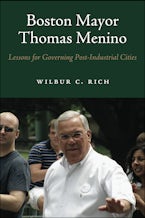- Home
- Building Victorian Boston

Building Victorian Boston
The Architecture of Gridley J.F. Bryant
Published by: University of Massachusetts Press
240 Pages, x 0.90 in
Other Retailers:
Much of Boston's rich heritage of Victorian buildings dates from the mid-nineteenth century when Gridley James Fox Bryant (1816–1899) dominated the profession of architecture in the city. At that time, Boston was undergoing a transformation from a quaint post-colonial town to a rapidly expanding Victorian metropolis. Bryant led this transformation, providing an important link between the earlier architecture of Charles Bulfinch and Alexander Parris and the later work of such practitioners as H. H. Richardson and Peabody & Stearns.
In Building Victorian Boston, Roger Reed focuses on representative projects by Bryant, presenting them in a chronological narrative that both illuminates the trajectory of his career and creates a portrait of the profession of architecture during a defining period of New England history. Bryant designed more major buildings in Boston from 1840 to 1880 than any other architect. He also undertook commissions throughout New
England, especially in towns linked to Boston by newly constructed railroad lines. In many ways, his practice presaged aspects of modern architectural firms. His ability to work with a variety of designers, his expertise in construction management, and his exceptional talent for self-promotion all contributed to his success. Although by the time of his death his work was no longer fashionable, newspaper accounts noted the passing of the "Famed Bostonian" and "Great Builder" whose career had had such a dramatic impact on the face of the city.
For this volume, Reed has tracked down hundreds of Bryant's drawings as well as specifications, letters, newspaper articles, published renderings, and historical photographs. These materials are amply represented in this book, the definitive study of a quintessential Victorian architect.
In Building Victorian Boston, Roger Reed focuses on representative projects by Bryant, presenting them in a chronological narrative that both illuminates the trajectory of his career and creates a portrait of the profession of architecture during a defining period of New England history. Bryant designed more major buildings in Boston from 1840 to 1880 than any other architect. He also undertook commissions throughout New
England, especially in towns linked to Boston by newly constructed railroad lines. In many ways, his practice presaged aspects of modern architectural firms. His ability to work with a variety of designers, his expertise in construction management, and his exceptional talent for self-promotion all contributed to his success. Although by the time of his death his work was no longer fashionable, newspaper accounts noted the passing of the "Famed Bostonian" and "Great Builder" whose career had had such a dramatic impact on the face of the city.
For this volume, Reed has tracked down hundreds of Bryant's drawings as well as specifications, letters, newspaper articles, published renderings, and historical photographs. These materials are amply represented in this book, the definitive study of a quintessential Victorian architect.
Roger Reed is a preservation planner in Brookline, Massachusetts. While working as an architectural historian for the Maine Historic Planning Commission, he wrote two books, A Delight to All Who Know It: The Architecture of William R. Emerson of Maine and Summerings on the Thoroughfare: The Architecture of North Haven.
"Roger Reed's impressive study of Gridley James Fox Bryant fills the missing link in Boston's nineteenth-century architectural history. Given the central prominence and extent of Bryant's work, it is surprising that this gap in our knowledge has existed for so long. The thoroughness and rigor of this new monograph, however, has made the wait worthwhile."—Keith N. Morgan, author of Buildings of Massachusetts: Greater Boston
"The text is eloquently written, well researched and documented, and laced with historic black-and-white illustrations, all a refreshing change from the recent meatless coffee-table books on local architecture. . . .In the arena of architectural bibliographies, this book stands at the top. . . . Highly recommended."—Choice
"Richly illustrated, well-constructed biography. . . . And 'well-constructed' is just the sort of book Gridley Bryant would have expected from his biographer."—The New England Quarterly
"Roger Reed's well-researched monograph about Bryant's life and career does much to restore him to his rightful position in the history of architecture."—Historical Journal of Massachusetts











